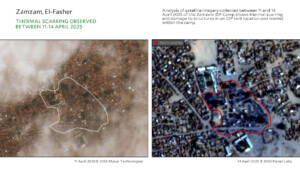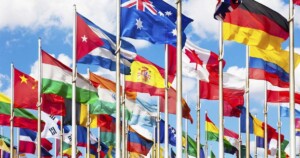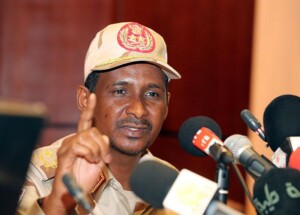Darfur: UNAMID drawdown complete as ‘liquidation phase’ begins
The African Union-United Nations Hybrid Operation in Darfur (UNAMID) will complete its drawdown exercise tomorrow (30 June 2021), as requested by UN Security Council resolution 2559 (2020), which ended the Mission’s mandate at the end of last year.
 UN Assistant Secretary-General M’Baye Babacar Cissé (SUNA)
UN Assistant Secretary-General M’Baye Babacar Cissé (SUNA)
The African Union-United Nations hybrid operation in Darfur will complete its drawdown exercise tomorrow (30 June 2021), as requested by UN Security Council resolution 2559 (2020), which ended the Mission’s mandate at the end of last year.
A statement issued by the UN-AU Mission in Darfur (UNAMID) today points out that “over the past four months, UNAMID handed over 14 team sites to the government, who committed to using them for civilian purposes as in line with the Framework Agreement signed on 4 March 2021. Facilities are to be utilised for health care, education, and other social services, including vocational training and community centres, as identified by community members.”
“Good coordination and cooperation with the government of Sudan has been critical for meeting the tight timeline and benchmarks set by the Security Council for the drawdown period. Similarly, it will be important for the government to ensure the protection of the Logistics Base and the repatriation of remaining staff to facilitate a seamless liquidation phase,” said UN Assistant Secretary-General M’Baye Babacar Cissé, who was tasked to oversee the drawdown period, manage personnel and asset repatriation, transfer team sites to local authorities, and engage with the government on relevant issues.
The statement points out that “while it is the responsibility of the central government to ensure the safety and protection of the sites, the Darfur state governments remain responsible for ensuring the facilities are being used as intended”.

As previously reported by Radio Dabanga, the ongoing insecurity in Darfur, often partly attributed to the vacuum created by the UNAMID drawdown, has meant that the practicalities of the handover of sites and facilities has not always gone as planned.
On June 5, two people were killed and eight others sustained injuries when a former UNAMID site in Shangil Tobaya, Dar El Salaam locality, south of El Fasher in North Darfur was looted.
The site was handed over to the Government of Sudan on May 25. It was the last of 14 deep field sites handed over to the Sudanese government. At the time, the North Darfur government and the Sudanese government’s joint task force strongly reconfirmed their commitment to ensure civilian use of the former site.
Since the mission ended its mandate at the end of last year, various former UNAMID sites handed over to local authorities to be used as schools or training centres, have been looted since.
In February, a site in North Darfur’s Saraf Omra that was earmarked for use as a vocational training centre was looted and ‘levelled’ just weeks after it was handed over to the Sudanese government.
UN Secretary-General António Guterres publicly condemned the looting at the time and said: “at a time when community needs in Sudan are increasingly pressing, the site was intended to serve as a vocational training centre; unknown assailants have dashed that opportunity”.
Liquidation phase
Today’s statement says that so far, UNAMID, as an integral part of its drawdown, provided Darfur communities with 193 vehicles, including 27 water and sewage trucks and 196 generators. The Mission also donated its clinic in Zalingei as well as medical facilities in Nyala and Kabkabiya for use by the local communities.
However, the statement acknowledges that “due to its size, both in terms of personnel and assets, as well as its geographical footprint, UNAMID faced challenges during the drawdown period, but was able to undertake it without major incidents”.
As the Mission transitions into its liquidation phase, which is likely to last another year, significant tasks remain such as the transition and handover of the El Fasher camp to the authorities in Darfur, the disposal of remaining assets, the completion of the environmental clean-up and restoration, the disposal of hazardous materials including expired ammunition, and the repatriation of equipment and uniformed and civilian personnel.
As authorized by the Security Council, the Mission in its year-long liquidation phase scheduled to commence on 1 July 2021, will maintain a guard unit consisting of 363 formed police unit to protect UN personnel, facilities and assets inside the El Fasher Logistics Base. In parallel, Sudanese joint forces will continue to be deployed outside the Base, under the direction of the Government of Sudan and in close coordination with the UNAMID Liquidation Team. These forces will have the shared responsibility of securing the perimeter of the base, providing safety and security for UN personnel and ensuring that onward convoys of assets and contingent owned equipment are able to proceed without incidents.
While UNAMID completed its mandate on 31 December 2020 and the drawdown by 1 July 2021 and is now in a full-fledged liquidation phase, the United Nations is not leaving Sudan. UNAMID has coordinated regularly with the United Nations Integrated Transition Assistance Mission in Sudan (UNITAMS) and the United Nations Country Team (UNCT), sharing best practices and lessons learned on its work in Darfur to consolidate and scale up the peacebuilding gains that have been made, the statement concludes.
UNAMID (Source: UN)
During UNAMID’s 13-year mandate, more than 100,000 military and police peacekeepers were contributed by dozens of countries from around the world. At its peak deployment in 2011, it had nearly 23,000 troops and police.
At the beginning of the drawdown period in January 2021, 7,000 military, police, and civilian personnel remained to be separated and repatriated, with over 6,000 now repatriated.
UNAMID, one of the largest peacekeeping operations in the history of the United Nations, created a security environment in Darfur and will be departing with a history of achievements supporting the protection of civilians, particularly the internally displaced persons, community stabilization and rule of law support, the provision of humanitarian aid as well as supporting the implementation of the peace process. The Mission also worked to empower women; addressed sexual and gender-based violence; protected and promoted human rights; and helped with the fight against COVID-19.
Facts and Figures
Protection of civilians
– 38,000 peacekeeping patrols conducted annually to protect hundreds of thousands of IDPs.
Programmatic activities
– 120 meetings, dialogue forums and peace campaigns with farmers and nomadic herders to mitigate intercommunal violence, promoting peaceful coexistence and facilitating amicable use of scarce shared natural resources.
– 500+ quick impact projects were implemented in Darfur, including 94 water boreholes and water points were established in hotspots.
Community Stabilization
– Rehabilitation of classrooms, construction of prosecution offices, community security and small arms control, provision of solar panels and temporary job creation for at-risk youth.
State Liaison Functions (SLF)
– 46 million USD allocated to SLF in 2 years.
– 10 UN Agencies, Funds and Pgrammes participated in SLF programming.
COVID-19
– $1.9 million USD allocated by UNAMID/UNCT for COVID-19 response in FY 2019/20 – SLF 4
– Training of trainers workshops and sensitization sessions on COVID-19.
– 30+ different types of PPE donated to communities in Darfur (goggles, gloves masks, etc.)
Police and Rule of Law
– 45 Sudan Police Force stations/posts, 15 prosecution offices, 19 District Courts, 14 prisons and 14 rural courts to support policing services, dispensation of justice and addressed intercommunal conflicts and criminality.
Security Sector
– 1,300+ former child soldiers released who were registered by Sudan Disarmament, Demobilization and Reintegration Commission (SDDRC) in Darfur.
– 11,000 ex-combatants were demobilized and benefitted from reinsertion packages.
Gender
– 54 Women’s Protection Networks supported across the five Darfur States which provide real time information as first responders to security threats, including incidents of physical assault, rape, killings and abductions in the field to the security apparatus, for quick response.
– 120 women were brought to Juba peace talks from Darfur.
Drawdown
– 14 team sites handed over in less than 4 months.
– 5 team sites looted, 3 team sites faced criminality.
– 7,000 personnel at start of drawdown. 6,000 separated/repatriated.
– 363 police will remain with Guard Unit during liquidation period.
– 103 SLF activities remained to be implemented in January, 28 core programmatic projects.
– 99 UNAMID staff were embedded with AFPs to support the implementation (during drawdown.
– 5 contingents’ COE has been sent/returned to home country (2 Jordanian FPU, Senegalese FPU, Kenyan military police unit).
– 60 trucks of COE leave the Logistics Base/day en route to Port Sudan.











 and then
and then